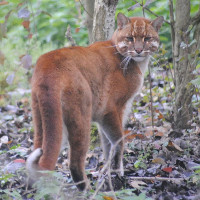 |
African golden cat |
|
He is a wild animal |
Origin |
Equatorial Africa | |
Translation |
Francis Vandersteen |
| The possession of this animal is not authorized Royal Decree establishing the list of mammals not kept for production purposes that may be kept (M.B. 24.08.2009) |
| The African golden cat is a species of wild cat belonging to the feline family in the Profelis genus. However, some organizations such as the IUCN recognize the African golden cat as belonging to the genus Caracal. The African golden cat is an average 80 cm long cat. Some specimens can measure up to 1.05 m in length, with a tail of almost 55 cm. Adult weight varies between 5 and 15 kg. This feline is covered with a short golden-brown coat, except for the throat and chest, which are whitish. Coat color sometimes varies from russet to sepia gray, with or without flecks. The tail is marked with a black line and ends in a black or brown patch. It has a round face topped by a pair of small, rounded ears with black backs. Unlike the caracal, which belongs to the same genus, these ears have no feathers at their tips. The African golden cat is endemic to the forests of equatorial Africa. To date, there is no confirmation of the species' existence in Guinea, Togo and Benin, suggesting a separation between populations living in the west of the continent and those in the center. The African golden cat is found in Angola, Gabon, Ghana, Guinea, Kenya, Liberia, Nigeria, Rwanda, Senegal, Sierra Leone, Burundi, Cameroon, Central African Republic, Congo, Côte d'Ivoire, Equatorial Guinea and Uganda. It lives mainly in lowlands and rainforests. But it can also be found in recently logged forests along rivers, and in forested mountain areas. The African golden cat hunts mainly at dusk. Its diet generally consists of birds, snakes and small mammals such as mice and rats. Occasionally, it will attack larger prey such as small antelopes, monkeys and sometimes sheep and goats. Little is known about the behavior of the African golden cat. We do know, however, that it is a solitary animal which, like many felines, defends its territory and marks it with its feces and by scratching tree bark. It is a terrestrial hunter and, despite its nocturnal habits, can hunt during the day. It is also known to raid chicken coops and prey on domestic goats and sheep. The lack of information on the biology and current populations of the African golden cat makes it impossible to accurately determine the current status of this feline in the wild. However, we do know that deforestation is a real threat to the species. The rainforests of West Africa have been severely degraded, and the remaining areas are unevenly distributed. Agriculture and logging have probably led to population declines and fragmentation. Although the African golden cat is rarely hunted by humans, skins of this cat can nevertheless be found on market stalls. With deforestation and population growth, the prey this cat feeds on is also becoming rarer, forcing it to prey on farmers livestock. This practice often leads farmers to shoot the cat as soon as it gets too close to their land. |






 English (United Kingdom)
English (United Kingdom)